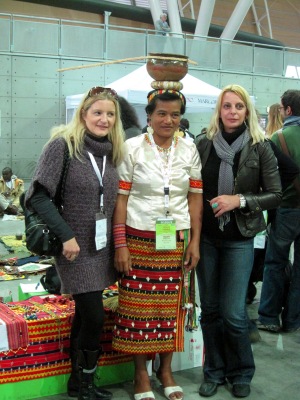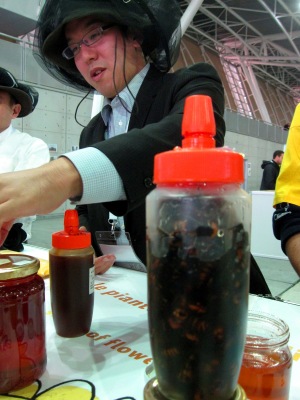

Delegate from the Philippines demonstrates her prowess at balancing objects on her head; Japanese beekeepers gather at the Honey Bar
At the registration for Terra Madre, small pins were passed out depicting the silhouettes of a farmer and a soldier, with an equals sign between them. In many ways, this icon summarizes what Terra Madre is about. It is a gathering of food communities and food producers, and a strategy session on how best to battle the onslaught of industrialized food, environmental degradation and social injustice. (Update: I’ve learned that the pins are from Slow Food Nation, and actually depict farmer = Statue of Liberty. Apparently I glanced at it too quickly.)
The opening ceremony is reminiscent of the Olympics, partly because it takes place in the Palasport Isozaki, an arena built for the 2006 Torino Olympics. Rather than athletes though, the crowd was cheering for farmers, fishermen, chefs and researchers. With much fanfare and applause, representatives from 160 countries paraded into the stadium carrying their nation’s flags. They were accompanied by a youth choir and orchestra that had been set up in the stands, complete with several harps and a marimba. This was followed by a series of speeches by representatives of indigenous peoples, such as the Guaranì of Brazil and the Kamchadal of Russia.
At last, Slow Food founder and figurehead Carlo Petrini took the stage. “The principal custodians of traditional knowledge,” he said, “are the indigenous peoples, the farmers, the women and the elderly, the very categories that today’s institutions and media pay the least attention.” He went on to address the students in the audience. “You have been given a grand opportunity to reconcile science and modern technology with traditional knowledge.” Petrini declared that the conference had officially commenced, as the crowd roared and leapt to their feet. The last time I was in a crowd this excited was at the Obama rally in Chicago on election night.
Continue reading The Terra Madre Formula: Farmer = Revolutionary




